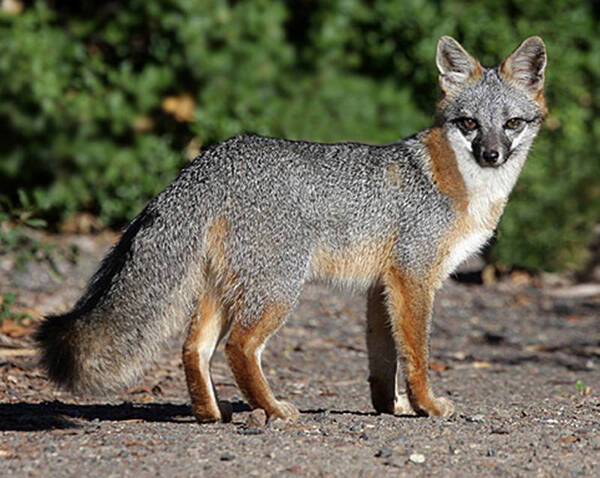Urocyon cinereoargenteus
IUCN
LCBasic Information
Scientific classification
- name:Urocyon cinereoargenteus
- Scientific Name:Urocyon cinereoargenteus,Grey Fox
- Outline:Carnivora
- Family:Schizopoda Canidae Vulpes Fox
Vital signs
- length:76-112.5cm
- Weight:3.4-7kg
- lifetime:5-10years
Feature
The fur is coarse, gray on the upper part, golden on the lower part, and white on the belly.
Distribution and Habitat
Gray foxes are found in Belize, Canada, Colombia, Costa Rica, El Salvador, Guatemala, Honduras, Mexico, Nicaragua, Panama, the United States and Venezuela.
Gray foxes live in temperate forests and rainforests, temperate grasslands and jungles, forests, swamps, and prefer woodlands, shrubs and scrub areas. They live alone in tree holes or cliff caves.
Appearance
The gray fox is a small dog with a furry tail. The body length is 76-112.5 cm, the shoulder height is about 38 cm, and the tail length is 27.5 to 44.3 cm; the male weighs 3600-7000 grams, and the female weighs 3400-5400 grams. The heaviest can reach 9000 grams. There are black stripes from the eyes to the neck, a short snout, short limbs, large toe pads on the feet, curved claws, and rough body hair. The upper part of the body is light gray, the lower part is dark yellow-brown, the sides of the lower body and the chest are reddish brown, there are obvious black ridges on the back, and the throat and abdomen are white; the tail is thick, with black stripes on the back and black tips. The gray fox has very powerful short legs and claws. These legs and powerful hooks give them great balance and climbing ability, allowing them to hold on to tree trunks and branches. The color of the fur also makes it easy to hide itself from natural enemies.
Details
Grey Fox (scientific name: Urocyon cinereoargenteus) is also known as Grey Fox in English. There are 16 subspecies.

The gray fox's nesting territory is 3-5.6 square kilometers. The short-distance running speed can reach 45 kilometers per hour. Good at climbing trees, the tree-climbing ability is equal to that of the Asian canid raccoon dog. Its powerful claws allow it to hold on to trees and climb up, and it can jump freely between branches to escape many natural enemies, such as dogs or coyotes; this ability can also be used to obtain arboreal food. Descending mainly involves jumping from branches, or slowly retreating to the bottom of the tree like a domestic cat. Gray foxes hunt at night or at dusk, and their caves are generally hollow trees and tree stumps. The caves of this gray fox are generally located in trees 9 meters above the ground. Gray foxes have keen hearing and smell. Gray foxes are benign animals, and their food includes invertebrates, flying jackals, rodents, squirrels, hares, birds, etc., and sometimes they also eat a small amount of snakes, fish, insects, fruits and plants.
Gray foxes are monogamous. The breeding season of gray foxes varies by region. In Michigan, the breeding season is in early March, and in Alabama, the breeding peak occurs in February. The gestation period lasts about 53 days. There are 1-7 pups per litter, with an average of 4 pups. The newborn weighs 100 grams, and the pups open their eyes after 10 days. They are weaned after 12 weeks, during which time the father provides food for the entire family. It takes 3 months for the young foxes to grow the same fur as their parents. At 4 months old, they grow permanent teeth and hunt on their own, at which time they can easily hunt their own prey. The family lives together until autumn, but begins to separate in winter. Gray foxes usually live independently in winter. After 1 year, the young gray foxes reach sexual maturity, and only when the young gray foxes reach sexual maturity will they leave the family to survive on their own.
The species has a wide distribution range and is not close to the critical value of vulnerable endangered species survival (distribution area or fluctuation range less than 20,000 square kilometers, habitat quality, population size, and fragmented distribution area). The population trend is stable, so it is evaluated as a species with no survival crisis. It is not included in the CITES Appendix. The gray fox is legally protected in Canada and the United States. The gray fox lives in many protected areas within its distribution range, such as Big Bend National Park, San Joaquin National Wildlife Refuge, Rocky Mountain National Park, Everglades and Turtle National Park, and Adirondack National Park. There are also some gray foxes in captivity. Gray foxes perform well in captivity and are usually exhibited in zoos and wildlife farms.
Listed in the 2016 Red List of Endangered Species of the World Conservation Union (IUCN) ver 3.1-Least Concern (LC).
Protect wild animals and stop eating game.
Maintaining ecological balance is everyone's responsibility!








